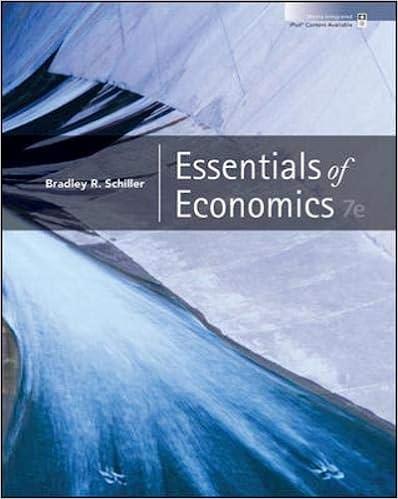Question
20. Suppose goods X and Y are produced along a production possibilities frontier 4X 2 + Y 2 = 500 and they are perfect substitutes
20. Suppose goods X and Y are produced along a production possibilities frontier 4X2+ Y2= 500 and they are perfect substitutes such that U = X + Y. The slope of the production possibilities frontier is -X / (2 Root 500 - X^2). How much Y should be produced?
a. 0 / b. 5 / c. 10 / d. 20
ANSWER: b
1. Consider a two-good production economy in which both goods are produced with fixed proportions production functions. Then, some efficient allocations will exhibit unemployment of some factor providing
a. the firms use the inputs in different proportions.
b. the firms exhibit diminishing returns to scale.
c. the firms exhibit increasing returns to scale.
d. production can never be efficient if there are unemployed inputs.
ANSWER: a
14. Suppose the Economics Department has a graduation party for its students but as a final test they must show they have learned something about trade. The men are given food when they walk in and the women are given drink. Suppose they have identical preferences where food and drink provide utilityU = FD. The contract curve in the Edgeworth box using a representative man and woman would be
a. a right angle connecting the lower left corner with the upper right corner.
b. a curve (not necessarily a line) connecting the lower left corner with the upper right corner.
c. a line connecting the lower left corner with the upper right corner.
d. a right angle connecting the upper left corner with the lower right corner.
ANSWER: b
16. Suppose the Economics Department has a graduation party for its students but as a final test they must show they have learned something about trade. The men are given food when they walk in and the women are given drink. Suppose they have very different preferences where food and drink provide utility. For menU = FD. For women U=min(F,D) The contract curve in the Edgeworth box using a representative man and woman would be
a. a right angle connecting the lower left corner with the upper right corner.
b. a curve (not necessarily a line) connecting the lower left corner with the upper right corner.
c. a line connecting the lower left corner with the upper right corner.
d. a right angle connecting the upper left corner with the lower right corner.
ANSWER: c
NOTES:Answers are already given but need a detailed explanations to these answers. Also explain the difference of the answers of #14 and #16. Thank you.
Step by Step Solution
There are 3 Steps involved in it
Step: 1

Get Instant Access to Expert-Tailored Solutions
See step-by-step solutions with expert insights and AI powered tools for academic success
Step: 2

Step: 3

Ace Your Homework with AI
Get the answers you need in no time with our AI-driven, step-by-step assistance
Get Started


